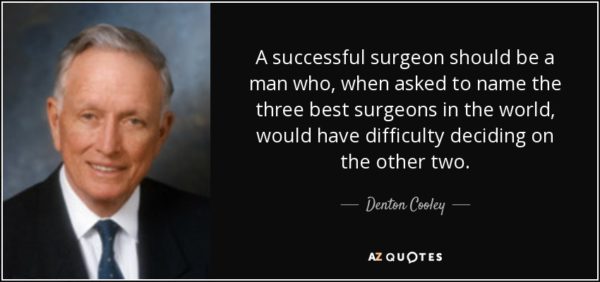
Denton A. Cooley, Bigger than Texas
Modify, simplify, apply
Denton A. Cooley, motto of The Texas Heart Institute.
A story had circulated about Denton Cooley, the famous Houston-based surgeon and innovator, an exceptionally gifted man. While testifying in court, Dr. Cooley was asked by the opposing attorney if he considered himself to be the best heart surgeon in the world.
“Yes, I do,” was the answer.
“Don’t you think that’s a little immodest, doctor”? The young, smirking lawyer asked, looking at the jury bench.
“Sure,” answered Cooley, “but remember, you put me under oath.”
I once visited the Texas Heart Institute, had a chance to meet Dr. Cooley, and watch his work. I saw a tall, maybe 6-4 man with an inviting smile, always surrounded by a group of young men and women, all dressed in green scrubs. From his office, he watched TV monitors showing the progress of work in each operating room, and knew when they needed him. I witnessed Cooley, scrubbed, came to the room I was visiting. The surgery was well in progress, the heart was on the bypass, left atrium opened and mitral valve exposed. He looked at the diseased valve, took a valve sizer, told the surgeon which valve to use, and left the room. They will know what to do. Then he walked to the other room, did the distal anastomoses on the other heart, and left. At this pace, he could do more than 100,000 operations in his career. I don’t think he saw all the cardiac catheterization films before every surgery, which we, mortals, had to study in detail. In each room, taped to the IV pole, I saw a sheet of paper with a diagram of coronary vessels and patients’ anatomy marked on them. It were just too many details to remember. By the end of the day, he held a meeting with his patients’ families. The room was full of people. From a sheet of paper, he called the patient’s name and gave a brief description of the procedure to each group. It looked more or less like a presidential press conference.
It struck me how well was he organized. His instrument tray had maybe one-third of mine. I realized then that we kept resterilizing and restocking many pieces that we don’t use or use only sporadically. His scrub used a much smaller Mayo table, while our display table was much bigger and more cumbersome.
And he was fast. No unnecessary movements. To appreciate that, you have to have cardiovascular training. It’s like watching Tiger Woods making the shot and being in awe––how did he do it?
[embedyt] https://www.youtube.com/watch?v=WJEysanOT7w[/embedyt]Or watching Alex Ovechkin scoring from the impossible angle. It helps when you know the game.
[embedyt] https://www.youtube.com/watch?v=bw2JGVos_Mw[/embedyt]There is some controversy about who did the first heart transplant in the United States. Everybody agrees Cooley was one of the firsts. In the interview, which I linked below, he describes why this milestone presented such a unique problem.
The difficulty was not with a technical part of the procedure. In 1968, many surgeons were capable of doing a heart transplant. The problem was with the timing of harvesting of an organ from the donor. Traditionally, death was pronounced when the heart had stopped. This was incompatible with the use of the same organ for transplantation. It was too late. Subsequently, the concept of ‘brain death’ was formulated, and that made organ harvesting much more practical. By defining the brain activity as the determinant of life, the heart still could be a well-functioning organ and a capable candidate for sustaining another life.
Well, in 1968 the definition of brain death was just formulated and not widely accepted yet. For his first transplant, Cooley took a heart from a victim of a gunshot wound to the head. So, according to the widely accepted Vatican definition, he took the organ from the person still alive. For that, he faced the ethic problems himself. But this was also skillfully used by the bright attorney defending the person who did the shooting. He got off the hook on the basis that he was not the person who killed the victim. Cooley was. Another good lawyer helped the surgeon get off the hook.
But the re-defining of a patient’s death didn’t solve all the problems for the doctors. Their patients were dying of rejection. Until cyclosporine opened the path to ethical acceptance of the heart transplants.
Cooley was a high risk-taker, not only in his professional life. Most of the prominent people are. In January 1988, after a series of careless real estate investments, he declared bankruptcy. It must have hurt a lot, since the broker who helped him with all the transactions was his son-in-law.
Denton Cooley was a basketball star and a starter for the University of Texas Longhorns. Many times he stressed that athletics, and team sports, in particular, help develop discipline and character in young people. I can attest to that. It worked for me and my children.
I’ve always thought that my exposure to competitive sports helped me a great deal in the operating room. It teaches you endurance, and it teaches you how to cope with defeat, and with complications of all sort. I think I’m a well-coordinated person, more than average, and I think that comes through my interest in sports, and athletics. … [Playing basketball] You have to make decisions promptly, and that’s true in the operating room as well.
Cooley’s surgical lineage was impeccable. He was a resident of Alfred Blalock, who, in turn at Johns Hopkins, was gifted William Halsted’s chair. Cooley was present at the first ‘blue baby’ operation, and saw Vivien Thomas, Blalock’s African-American assistant, giving his boss instructions on how to do the surgery, while standing behind his back. At that time, Vivien was not allowed to scrub to the procedures. He was employed as an orderly.
Throughout my surgical life, I felt wonderment each time I saw the heart. But the strongest impression was a view of this tireless organ temporarily stopped for a given surgical procedure, miraculously coming back to function after the surgery was over. Each time I was in awe. I was glad to find this quote in Dr. Cooley’s citations.
[The heart is] really a fascinating organ. It’s about the only organ in the body that you can really witness its function. Doing things. And so on. Some other organs you can witness, like the intestines, will have this sort of peristaltic motion. But nothing that can compare with the activity of the human heart.
Here is a link to the superb interview with Dr. Cooley done by Dr. William Stoney https://tinyurl.com/ycoptutb
But one of the most talked about parts of his life was the feud with his one-time mentor, Dr. Michael DeBakey.
More about it later.

5 Comments
Good Morning Dr.
I’m always fascinated by the human body…especially the heart. I look forward to your posts.
Wishing you and your family good health
Marcia
Thanks, Marcia. Heart is a mysterious creation. It seems to be a mechanical device, still for millennia is seen as a center for person’s feelings.
Fascinating insight into the man and the legend. Thank you.
I always have been in awe of holding a human heart as you are holding that person’s life in your hands
The biggest paradox is the fact, that you can do it, while the rightful owner can’t.